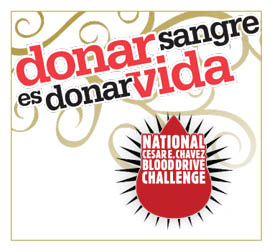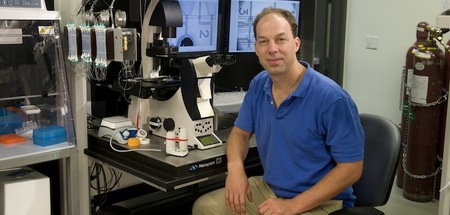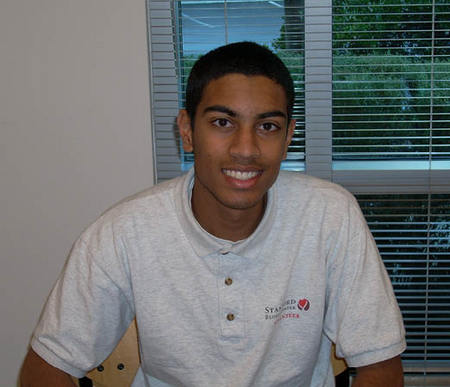April 3, 2013 at 8:00 am
Published by Stanford Blood Center

By Ruthann Richter, Director of Media Relations for the department of Communications & Public Affairs at the Stanford School of Medicine
Ed Engleman, MD, Stanford Blood Center's director, strode briskly into the large lecture hall at UC-San Francisco, eager to describe the screening test he and his colleagues had just developed - a test they thought could help save the nation's blood supply from a looming threat.
March 28, 2013 at 11:01 am
Published by Stanford Blood Center

By Julie Peachey, Social Media Manager, Stanford Blood Center
Since 2009, student leaders nationwide have been participating in the National Cesar E. Chavez Blood Drive Challenge to promote civic engagement in honor of the Latino American civil rights activist.
March 26, 2013 at 11:19 am
Published by Stanford Blood Center

By Harpreet Sandhu, SBC Administrator
I am delighted to share with you a link to the latest edition of Stanford Medicine Magazine, which focuses on blood. We had the pleasure of working with the School of Medicine Office of Communication & Public Affairs to produce this special edition, in the hope that it would help raise awareness about the importance of donating blood and our unique mission.
March 21, 2013 at 2:06 pm
Published by Stanford Blood Center

Stephen Quake, PhD, Professor of Bioengineering and Applied Physics at Stanford University, will be speaking at our Café Scientifique series on Thursday, March 28 at 7 p.m.
Topic of Discussion
We are living in the genome age, where the productivity of DNA sequencers is advancing faster than Moore's Law. Dr. Quake will describe one contribution of biophysics to this field - the development of the first single molecule DNA sequencer. He will then go on to discuss several applications of high throughput DNA sequencing in medicine, ranging from non-invasive diagnostics to the first clinically annotated human genome.
March 19, 2013 at 10:53 am
Published by Stanford Blood Center
By Billie Rubin, reporting from the labs of Stanford Blood Center
Certain patients receiving blood transfusions require specific compatibility testing beyond the ABO type and Rh factor that we commonly hear about, (A+, A-, B+, etc.). This is typically the case with those who have been transfused many times, such as sickle-cell anemia patients.
March 11, 2013 at 2:20 pm
Published by Stanford Blood Center
By Jill Clardy, Stanford Blood Center blood donor
I was always terribly afraid of needles. But in the mid-1990's when my friend Evelyn was diagnosed with leukemia and needed apheresis donors, I went with a group of coworkers to the Welch Road facility to donate and be tested as a potential donor. Though I was not able to donate for her, I realized that my fear of needles was completely unfounded, and have been donating regularly ever since.
March 5, 2013 at 12:16 pm
Published by Stanford Blood Center

By Deanna Bolio, Public Relations Associate, Stanford Blood Center
If there's one thing we know about hockey fans, it's that they aren't generally squeamish about blood. That's a great thing for Stanford Blood Center (SBC), who hosted its seventh annual "Save a Life" blood drive with the Sharks Foundation on Saturday, March 2. One of the most well-attended drives each year, dedicated Sharks fans combined to donate 261 units of blood. Some donors were lucky enough to be thanked personally for their donations by Sharks players Tommy Wingels, Matt Irwin, and Jason Demers.
February 22, 2013 at 10:29 am
Published by Stanford Blood Center
By Billie Rubin, reporting from the labs of Stanford Blood Center
The antigens on the surface of red blood cells can be made out of proteins, carbohydrates, glycoproteins or glycolipids. The A and B antigens that we commonly hear about belong to the ABO system. You can think of the systems as family members determined by your genes.
February 15, 2013 at 6:00 am
Published by Stanford Blood Center

By Billie Rubin, reporting from the labs of Stanford Blood Center
According to an article from the Telegraph, these gentle guys' blood may be the next big thing in antibiotics, especially for bugs that have become resistant to our usual kind.
February 12, 2013 at 6:00 am
Published by Stanford Blood Center

By Julie Peachey, Social Media Manager, Stanford Blood Center
Our staff members are occasionally asked if their positions at Stanford Blood Center are volunteer roles. This question often engenders a chuckle from those imagining their full time jobs being full time volunteer work. But although our nursing, administrative, and other operational staff are paid employees, we do have a variety of volunteer roles to help us achieve our goal of providing blood products to patients in need. In fact, there are over 100 active volunteers who together donate 300-400 hours per week to SBC to help our operation run smoothly.







